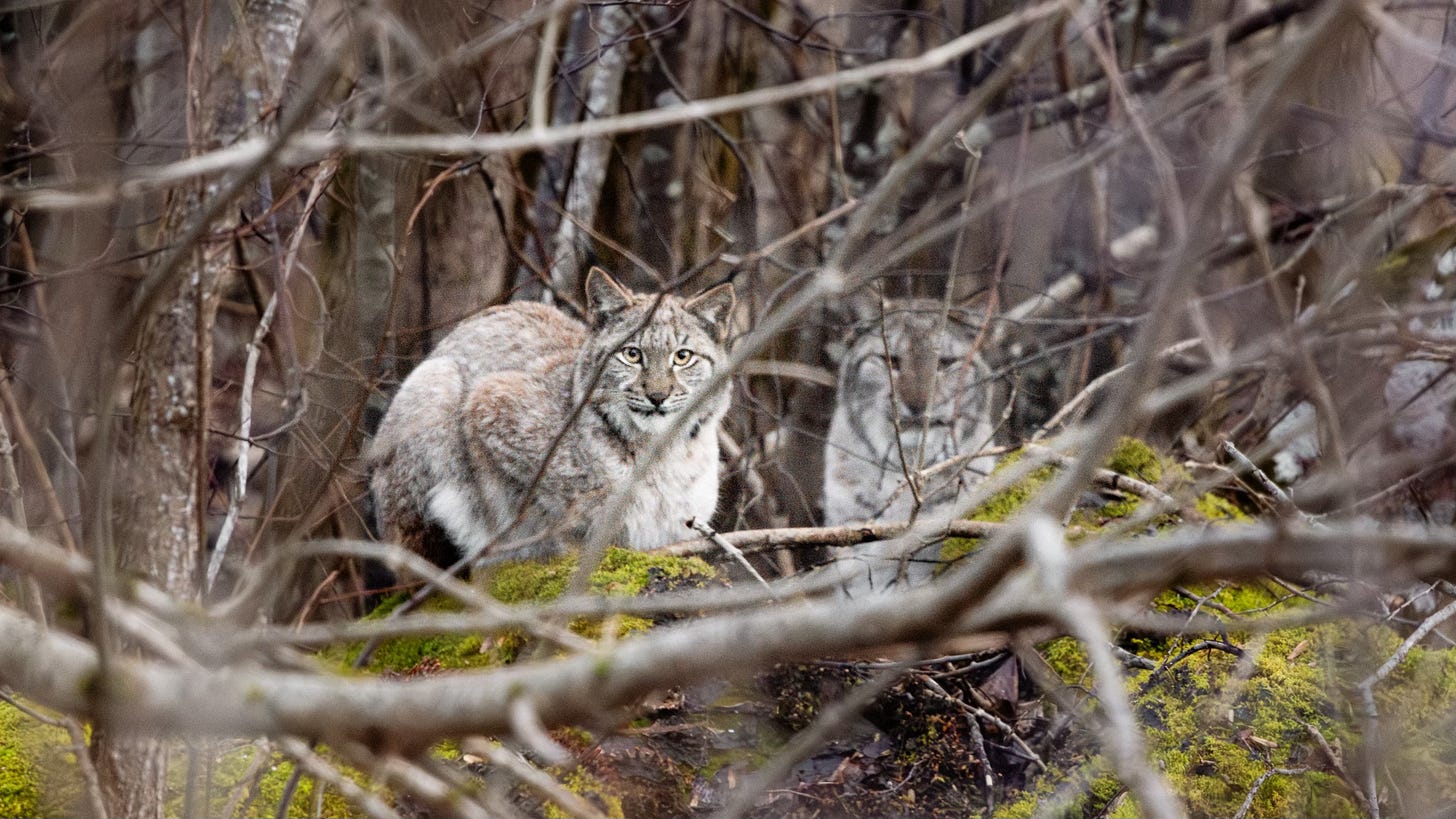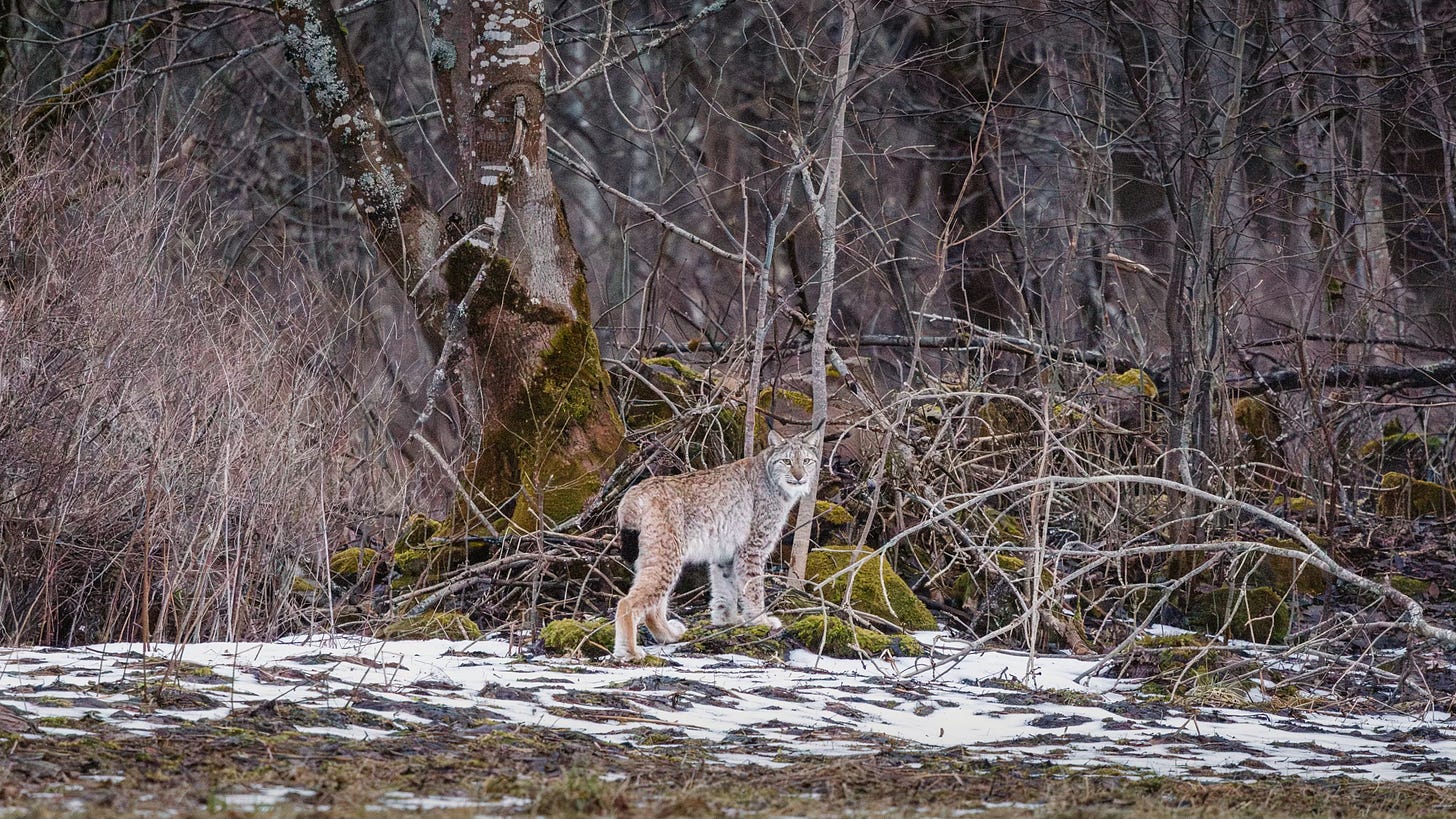A wild cat, her kitten and one very unexpected guest🎙️
Watching lynx break all the rules under a starlit sky
By Dan Fletcher
Here’s the audio edition of this newsletter, for those of you who prefer to listen!
I'm sitting in frozen grass on one of my last nights in Estonia, watching something that shouldn't be happening. Above me, Orion, the hunter constellation, twinkles in a crystal-clear sky — a fitting frame for the drama unfolding below. The air is sharp with cold, my breath billowing below the thermal scope as I watch three lynx meet in the darkness: a mother, her young-adult kitten, and a massive male. What I'm seeing challenges everything we've assumed about these supposedly solitary cats.
But let me back up. Earlier this week, I made what turned out to be a stupidly confident prediction about how rare daytime lynx sightings are. The universe decided to prove me wrong almost immediately. It began on Wednesday afternoon, just after sending out the last newsletter. We were driving through an area known simply as "Old Place" – a fitting codename for land that has hosted human settlements for five millennia. That's when Adam, my fellow photographer, spotted something extraordinary with his naked eye: not one lynx, but two — a mother and her young adult kitten, their tawny forms barely distinguishable among the moss-covered rocks and trees.
The encounter was fleeting but spectacular. But one good sighting just makes you want another, so as dusk approached the following evening, we headed back to the forests around Old Place, hoping to spot them again.
I was scanning the treeline with thermal binoculars, hoping to match Adam's keen eye from the day before, when another guide, Jillian Groeneveld, radioed in: he had spotted our pair again, this time engaged in something far more dramatic – a hunt.
We raced the van over and ditched it, creeping to the edge of the forest by foot, using Jillian's vehicle as cover. Before us, a scene straight from a wildlife documentary unfolded. Two roe deer circled nervously in the field, their instincts screaming danger. The female lynx waited at the woodland's edge, a study in patience. These cats are ambush predators – built for explosive short-distance attacks, not marathon chases. She knew her limits and was waiting for the perfect moment.

The script took an unexpected turn when a mountain hare appeared – its white winter coat conspicuous against the snowless ground. The deer, already on edge, fled at this new arrival. But the lynx's attention had shifted. From a few hundred yards away, she began a masterclass in stalking: methodical, precise, advancing in perfect sync with the hare's moments of distraction.
Her kitten, still learning the finer points of hunting, had other ideas. Impatient for a meal, it emerged from cover too soon, possibly contributing to the hare bolting suddenly across the field. I was already mentally writing up notes about the failed hunt when everything changed.
A call echoed from the forest depths, and a massive male lynx emerged from the shadows. What happened next didn't match anything I'd been told about these supposedly solitary cats. Instead of fleeing or showing aggression, the mother immediately abandoned her hunt, gathered her kitten, and together they approached the male. What followed wasn't a territorial dispute, but something that looked remarkably like a family reunion – three lynx, playing and interacting in the growing darkness before retreating together back into the forest’s cover.
Here’s video Groeneveld took on his thermal:
This moment crystallized something I've been grappling with in these newsletters: how much we still don't understand about the natural world. We often assume the science of wildlife behavior is settled, particularly for well-studied European species. But the truth is far more complex and humbling.
What we witnessed that night in Estonia might be common behavior for this stable, protected population. Or it might be extraordinarily rare. It could be completely different from how lynx behave in Sweden's hunting zones or in Switzerland’s fragmented populations. The point is: we don't know. And that's exciting.
Every time we step into the field, we have the chance to challenge what we think we know about the creatures we share this planet with. In an age where it sometimes feels like every mystery has been solved, it's cool to find that there are still discoveries waiting in the shadows of an Estonian forest, if we only take the time to look.

Thanks to Cat Expeditions along with Mark Kaptein and Martin Piispea for organizing this trip to find the Eurasian lynx while minimizing our disturbance to their environment.
Quick Links! 🔗
Eat more giant swamp rats! That’s the conservation message from US Fish & Wildlife service. The federal agency is encouraging Americans to help control invasive nutria populations by putting them on the dinner table. These 20-pound South American rodents are wreaking havoc on wetland ecosystems, but apparently make a mean gumbo. Louisiana's annual Nutria Rodeo already features everything from games of nutria cornhole to nutria tacos. As one chef put it: "tastes like chicken."
Yellowstone’s bison are now one big happy family. New research from Texas A&M reveals that Yellowstone's bison—once thought to be two distinct herds—have merged into a single interbreeding population of 4,000-6,000 animals. It's quite a turnaround from the early 1900s, when only 23 wild bison remained in the park. The finding means park managers can now focus on maintaining the overall genetic health of one unified herd, rather than trying to preserve two separate populations.
That’s it from me from Estonia! I hope you enjoyed getting to meet the Eurasian lynx as much as I did. I’m starting to work my way home for the spring where I plan on doing some stories around Colorado. If there are animals or ecosystems you’re interested in hearing more about — either in Colorado or around the world — please drop me a line at dan@fuzz.net.
And as we grow, please consider becoming a paying supporter. 100% of every paid subscription goes directly to conservation causes we choose together each month. Last month, FUZZ readers chose to support pygmy hippo conservation in West Africa. Next month? You’ll get to choose!







Incredible story! This reminds me a lot of recent discoveries that mountain lions aren't as solitary as once believed, either! Goes to show just how little we understand of even some of the most charismatic wildlife
I really enjoyed meeting the lynx